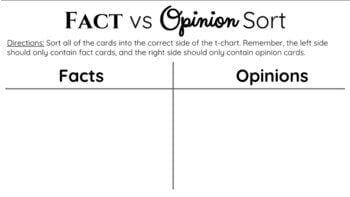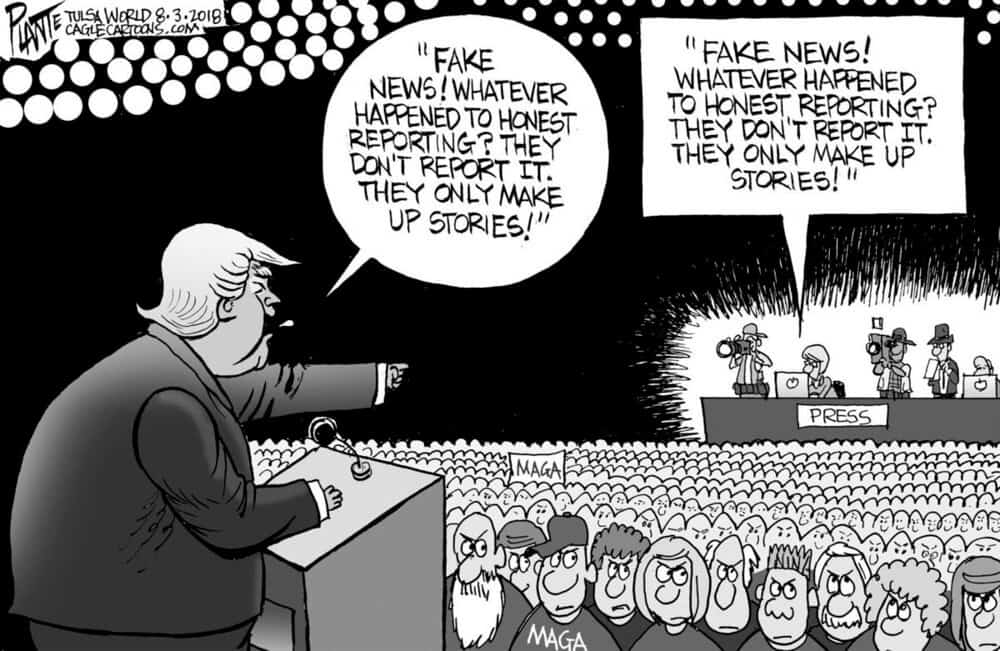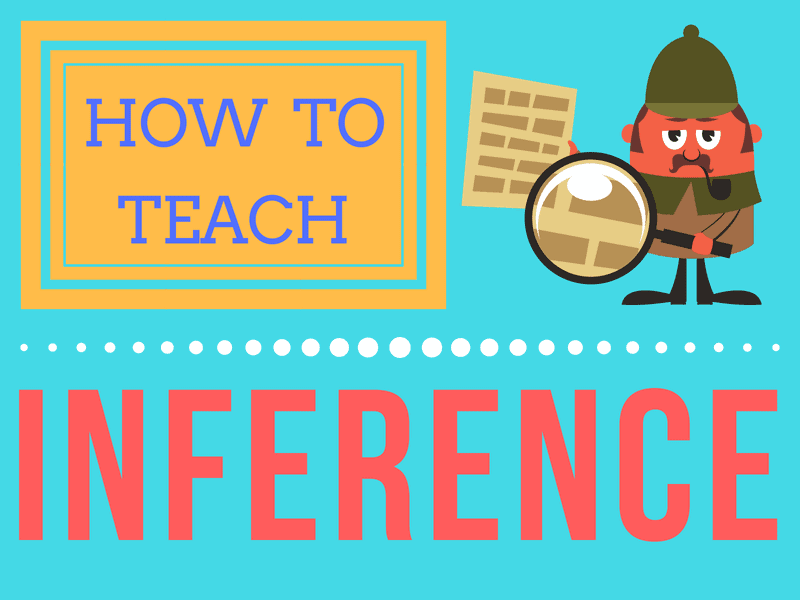Facts and Opinions About Reading Skills and Writing ?

DISTINGUISHING Between FACT AND Stance
For higher-level reading comprehension, it is essential that students are able to accurately distinguish betwixt fact and opinion. To do this successfully students must begin with solid definitions of the two concepts. Once this has been achieved, students must gain practice applying these definitions through activities that engage with a wide range of reading material.
Let'south accept a look at defining these two earth-shaking concepts:
WHAT IS A FACT?
A fact generally refers to something that is true and can be verified as such. That is, a fact is something that can be proven to be true.
A Consummate UNIT ON FACT AND Stance

Digital and social media has completely redefined the media landscape making it really hard for students to identify FACTS AND OPINIONS.
Teach them to FIGHT FAKE NEWS with this COMPLETE 42 PAGE UNIT. No grooming is required.
WHAT IS AN OPINION?
An opinion refers to a personal belief. It relates to how someone feels virtually something. Others may agree or disagree with an stance, just they cannot testify or disprove it. This is what defines it as stance.
Why Are Fact and Stance So Important?
The power to distinguish betwixt fact and opinion helps students develop their critical and belittling skills in both their reading and their listening. Fact and opinion are ofttimes woven together in texts and speeches. It is therefore imperative that students are able to unravel the threads of what is truthful from what is mere belief if they are to successfully navigate the deluge of media they will encounter in their lifetimes.
Whether on the news, in ad, or in a history volume, distinguishing between what is fact and what is stance is crucial to condign an autonomous person with the critical abilities necessary to avoid being manipulated easily.
The Linguistic communication of Fact and Opinion: Betoken Words and Phrases
As we mentioned to a higher place, often writers will liven upwards their facts with a sprinkling of opinion. Unfortunately, it can at times be difficult to excerpt the verifiable truths from the author's preferences and biases. Luckily the language used itself frequently throws up helpful clues in the forms of words and phrases that assist us in identifying statements every bit fact-based or opinion-based.
Permit's now take a expect at some examples of those signal words and phrases being used in the judgement fragments that often precede a statement of fact or opinion:
FACT
● The annual written report confirms …
● Scientists have recently discovered …
● According to the results of the tests…
● The investigation demonstrated …
Opinion
● He claimed that…
● Information technology is the officer'south view that…
● The report argues that…
● Many scientists suspect that…
As we tin meet from the above examples, the language used to innovate a statement can be helpful in indicating whether it is being framed as a fact or an opinion.
It is important for students to understand too that things are not ever as they appear to exist. At times, writers, whether consciously or not, will frame opinion as fact and vice versa. This is why it is important that students develop a clear understanding of what constitutes fact and opinion and are afforded aplenty opportunities to practise distinguishing betwixt the two.
WHAT IS CONTEXT?
Context is the circumstances surrounding an event, statement, or thought, and in terms of which it tin can exist fully understood. Facts and opinions must be placed in context to draw conclusions from.
For case, a young male child who tells his mother "I ate a truckload of sweets at the party final night" needs to exist placed in the context of his age, and audience.
We can confidently infer he never actually ate a real truckload of sweets, but we tin can reasonably capeesh he ate a lot of them and wanted to emphasise that bespeak.
His mother might inquire a clarifying question to plough that opinion into a hard fact.
USING GRAPHIC ORGANIZERS
Graphic organizers are a peachy tool to help students sort the facts and opinions in a text. Offering, as they do, a very visual means of organizing information, graphic organizers help students drill their ability to distinguish betwixt the two types of statements until they become automated.
Permit'south take a look at one peculiarly useful format for developing this skill:
The Fact and Stance Chart

This unproblematic chart consists of 2 columns helpfully labelled fact and stance beneath a topic heading. Students piece of work their way through a piece of text, sorting statements as they come across them into the appropriate column on the graphic organizer. At the stop of this task, they will be left with a clear segregation of the statements of the text co-ordinate to whether they are objective facts or subjective opinions.
Fact and Stance Activities: Honing the Skills
To become a skilled, critical reader a educatee must develop the ability to quickly evaluate a text for fact and stance. To achieve this, they must practice distinguishing between fact and opinion to a indicate where it becomes a subconscious machinery. The activities below will beget your students these necessary opportunities. They tin also hands be adapted to a range of ages and abilities through careful selection of the reading material. READ OUR Swell Article ON LITERACY GRAPHIC ORGANIZERS Hither
Fact and opinion activities for students
Educatee Activity 1. Top x Facts and Opinions
Non just does this simple activity help students strop their fact and opinion detecting abilities, information technology as well serves equally a great warm-upwardly research activity when beginning a new topic in class.
When starting a new topic, whether on a historical period, a literary effigy, or a species of animal, set students the task of listing x facts and opinions from their groundwork reading and research on their new topic. Students must then form and list ten opinions on the topic based on reflection on this initial reading and enquiry.
It may also be a useful exercise for students to look dorsum over their opinions at the end of the topic. Have they inverse their opinion in any areas of the topic? Why did they modify, or maintain, their opinion? This can work as a great review action to wrap things up.

Student Activity 2. Evaluate an Editorial
Newspaper editorials can be a superb resources for students to practice recognizing facts and opinions. They are filled with the editor'south opinions on the bug of the day, intermingled with facts that are selected to support that opinion.
First, give students copies of a newspaper editorial. Then, working in pairs, have students go through the editorial identifying the facts by underlining them and the opinions by highlighting. Remind them to look for the signal words we covered before to help identify facts and opinions.
When they have finished, students can then compare their answers and discuss the reasons for the decisions they made. This will help to identify any areas of confusion within the course; providing you with useful data to inform your hereafter planning on this topic.
FACT AND Stance ACTIVITIES FOR STUDENTS
If y'all are looking for a broad range of engaging tasks to teach students almost fact and opinion, yous take plant it.
ThisHUGE 120 PAGE resources combines four distinct fact and opinion activities you lot tin undertake as aWHOLE GROUP or asINDEPENDENT READING GROUP TASKS in eitherDIGITAL orPRINTABLE TASKS.
Educatee Activity 3. Fact vs Opinion Survey
This activity can initially exist undertaken using statements compiled on a worksheet. After, students tin work through passages of text, or even through the textbook itself directly. Students only work through a serial of statements marking either F or O beside each to identify that statement as a Fhuman activity or an Opinion.
This activity is an constructive study grooming exercise as information technology helps students to filter factual content from stance. It also makes it easier for students to work out the underlying purpose of a text, whether information technology is designed to inform, persuade, or entertain. Students will soon begin to recognize that passages of text that contain more facts than opinions are most likely intended to inform, while a text that is more stance-based will most probable exist intended to persuade or entertain.
Student Activity four. The Great Fact or Stance Sort
Organize students into reasonable-sized groups of iv or five students. Provide each group with a jar containing a set of cards, each with a fact-based or an opinion-based statement printed on it. Students accept turns picking a carte from the jar and reading it to the group. The group discusses each statement before deciding if information technology a fact or an stance.
Students can so record the statements appropriately on the Fact and Opinion Chart described higher up or simply sort them into two piles.
This activity serves as an effective method to support struggling students as they go to acquire from those students who have already developed a firmer grasp of the two concepts.
Extension Exercise: Identifying Bias
One reason information technology is so of import for our students to learn to differentiate between fact and opinion is that this power is a stepping stone to detecting bias in a text. Students begin to evaluate a text for bias past first identifying how much of the text is fact-based and how much is based on stance.
Once this is done, students must so analyse whether the opinions expressed in the text are biased by considering whether the author has:
● Provided incomplete information
● Intentionally ignored or left out information to persuade the reader
● Allowed their own personal experiences to deject whatever sense of objectivity.
In Conclusion
Not simply is the ability to identify bias in the writing of others essential, but this knowledge volition also be of peachy do good to students when it comes to forming and expressing their own opinions.
Taking the fourth dimension to prepare and deliver discrete lessons on how to recognize fact and opinion in reading is essential. No matter how confident students are in distinguishing betwixt the two, they are nonetheless probable to benefit from further practice. Even the most cogitating of u.s.a. can remain ignorant of our ain biases at times!
To become the critical readers that our students aspire to become begins with the formation of clear definitions of the terms in the students' minds. These definitions must exist supported past examples and illustrations to achieve this. Student understanding must be further underpinned by practice in the classroom and at habitation. The activities above serve as a proficient starting point, just they are non sufficient on their ain.
Information technology will be necessary to farther support students to gain a deeper understanding of fact and opinion (and related concepts such every bit bias) by making regular reference to these concepts when engaged with students in lessons with other explicit objectives that are seemingly unrelated to fact and stance. Reinforcement should be persistent to ensure students develop house skills in this surface area.
With ongoing advances in technology, assessing the reliability and truthfulness of the media we eat on a daily basis has never been more challenging – or important.
OTHER GREAT ARTICLES RELATED TO FACT AND Opinion
Content for this page has been written by Shane Mac Donnchaidh. A former principal of an international schoolhouse and university English lecturer with 15 years of teaching and administration feel. Shane's latest Volume the Complete Guide to Nonfiction Writing can be found here. Editing and support for this article have been provided by the literacyideas team.
Source: https://literacyideas.com/teaching-fact-and-opinion/







0 Response to "Facts and Opinions About Reading Skills and Writing ?"
Postar um comentário